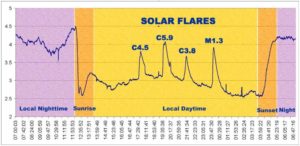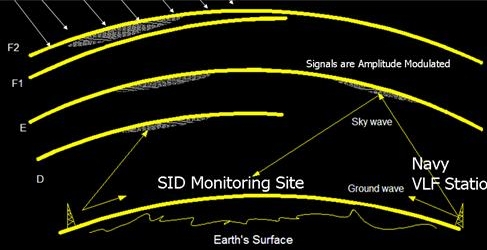What is a SID?
The Earth is surrounded by an electrically charged high altitude region in the atmosphere known as the ionosphere. It has several different layers. Due to ultraviolet and X-ray energy from the Sun, there are 4 layers during the day. Without the Sun’s energy overhead there are only two during the night.
| Daytime | Nighttime |
Each of the layers reflects radio waves differently.
At night VLF signals bounce off the highly reflective E layer back toward the Earth. Without any additional layers to pass through, nighttime signals are noticeably stronger than daytime signals.
During the day the VLF signals pass through a much less reflective D layer then on to the E layer where it is bounced back towards the Earth. It must then pass through the D layer again. Each time the signal passes through the D layer it looses energy. This results in a much weaker daytime signal.
| That is until the Sun unleashes a solar flare. |
Solar flares produce an incredible amount of ultraviolet and X-ray radiation that takes, on average, 8 minutes and 19 seconds to reach the Earth. The additional energy is enough to immediately ionize the D layer which becomes much more reflective. This results in a sudden increase in the strength of the received VLF signal, hence the name Sudden Ionospheric Disturbance (SID). The ionosphere may take minutes to hours to return to normal.
|
The strength and duration of the SID can be used to classify the solar flare. Notice how easy is is to see the signal strength change indicating the rising and setting of the Sun. |

|
The PTO monitors two VLF transmitters:
|
Both are US Navy facilities. VLF frequencies can penetrate about 130 feet of sea water and thus can be used to communicate with submerged submarines.

